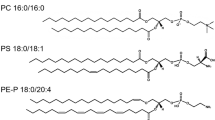Summary
Membrane rafts are ordered microdomains of the plasma membrane consisting of cholesterol, sphingolipids, and saturated fatty acids which appear to regulate many cellular signaling pathways. One such type of membrane raft is caveolae, which are cave-like invaginations of the plasma membrane. Interestingly, changes in the acyl composition of cellular membranes have been shown to alter the specific localization of membrane raft associated proteins and their function. This is noteworthy because modification of membrane acyl composition is readily accomplished through changes in dietary fat composition. Here we describe a common approach used to fractionate cell membranes to obtain an enriched preparation of caveolae and gas chromatographic techniques to determine fatty acyl composition. In addition, methods used to visualize and quantify lipid rafts using a fluorescent probe Laurdan in living cells will also be described.
Access this chapter
Tax calculation will be finalised at checkout
Purchases are for personal use only
Similar content being viewed by others
References
Pike, L. J. (2006) Rafts defined: a report on the Keystone symposium on lipid rafts and cell function. J. Lipid Res. 47: 1597–1598.
Ma, D. W., Seo, J., Davidson, L. A., Callaway, E. S., Fan, Y. Y., Lupton, J. R. & Chapkin, R. S. (2004) n-3 PUFA alter caveolae lipid composition and resident protein localization in mouse colon. FASEB J. 18: 1040–1042.
Ma, D. W. (2007) Lipid mediators in membrane rafts are important determinants of human health and disease. Appl. Physiol Nutr. Metab 32: 341–350.
Ma, D. W. L., Seo, J., Switzer, K. C., Fan, Y. Y., McMurray, D. N., Lupton, J. R. & Chapkin, R. S. (2004) n-3 PUFA and Membrane Microdomains: A New Frontier in Bioactive Lipid Research. J. Nutr. Biochem. 15: 700–706.
Fan, Y. Y., McMurray, D. N., Ly, L. H. & Chapkin, R. S. (2003) Dietary (n-3) polyunsaturated fatty acids remodel mouse T-cell lipid rafts. J. Nutr. 133: 1913–1920.
Fan, Y. Y., Ly, L. H., Barhoumi, R., McMurray, D. N. & Chapkin, R. S. (2004) Dietary docosahexaenoic acid suppresses T cell protein kinase C theta lipid raft recruitment and IL-2 production. J. Immunol. 173: 6151–6160.
Schley, P. D., Brindley, D. N. & Field, C. J. (2007) (n-3) PUFA alter raft lipid composition and decrease epidermal growth factor receptor levels in lipid rafts of human breast cancer cells. J. Nutr. 137: 548–553.
Michaely, P. A., Mineo, C., Ying, Y. S. & Anderson, R. G. (1999) Polarized distribution of endogenous Rac1 and RhoA at the cell surface. J. Biol. Chem. 274: 21430–21436.
Smart, E. J., Ying, Y. S., Mineo, C. & Anderson, R. G. (1995) A detergent-free method for purifying caveolae membrane from tissue culture cells. Proc. Natl. Acad. Sci. U S A 92: 10104–10108.
Kim, W., Fan, Y. Y., Barhoumi, R., Smith, R., McMurray, D. N.,& Chapkin, R. S. (2008). n-3 polyunsaturated fatty acids suppress the localization and activation of signaling proteins at the immunological synapse in murine CD4+ T cells by affecting lipid raft formation. J. Immunol. 181: 6236–6243.
Harder, T., Scheiffele, P., Verkade, P. & Simons, K. (1998). Lipid domain structure of the plasma membrane revealed by patching of membrane components. J. Cell Biol. 141: 929–942.
Anderson, R. G. (1998). The caveolae membrane system. Annu. Rev. Biochem. 67: 199–225.
Wilson, B. S., Pfeiffer, J. R. & Oliver, J. M.. (2000). Observing FcepsilonRI signaling from the inside of the mast cell membrane. J. Cell Biol. 149: 1131–1142.
Kenworthy, A. K., Petranova, N. & Edidin M. (2000). High-resolution FRET microscopy of cholera toxin B-subunit and GPI-anchored proteins in cell plasma membranes. Mol. Biol. Cell 11: 1645–1655.
Gaus, K., Chklovskaia, E., Fazekas de St Groth, B., Jessup, W.,Harder, T.. (2005). Condensation of the plasma membrane at the site of T lymphocyte activation. J. Cell Biol. 171: 121–131.
Gaus, K., Zech, T.,& Harder, T. (2006). Visualizing membrane microdomains by Laurdan 2-photon microscopy. Mol. Membr. Biol. 23: 41–48.
Rentero, C., Zech, T., Quinn, C. M., Engelhardt, K., Williamson, D., Grewal, T., Jessup, W., Harder, T. & Gaus, K.. (2008). Functional implications of plasma membrane condensation for T cell activation. PLoS ONE 3: e2262.
Acknowledgments
Supported in part by NIH grants CA59034, CA129444, DK071707, and P30ES09106 to R.S. Chapkin and a Natural Sciences and Engineering Research Council of Canada Discovery Grant to D.W.L. Ma.
Author information
Authors and Affiliations
Editor information
Editors and Affiliations
Rights and permissions
Copyright information
© 2009 Humana Press, a part of Springer Science+Business Media, LLC
About this protocol
Cite this protocol
Kim, W., Chapkin, R.S., Barhoumi, R., Ma, D.W.L. (2009). A Novel Role for Nutrition in the Alteration of Functional Microdomains on the Cell Surface. In: Armstrong, D. (eds) Lipidomics. Methods in Molecular Biology, vol 579. Humana Press, Totowa, NJ. https://doi.org/10.1007/978-1-60761-322-0_13
Download citation
DOI: https://doi.org/10.1007/978-1-60761-322-0_13
Published:
Publisher Name: Humana Press, Totowa, NJ
Print ISBN: 978-1-60761-321-3
Online ISBN: 978-1-60761-322-0
eBook Packages: Springer Protocols




